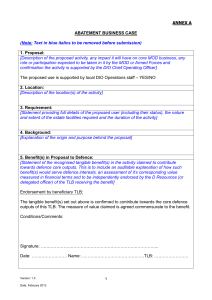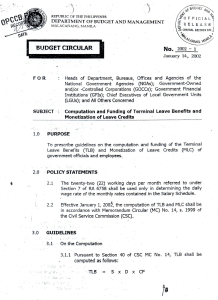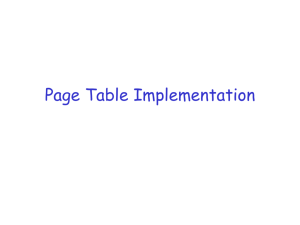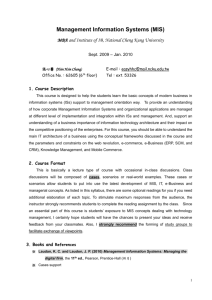10. Transportation Planning in SCm
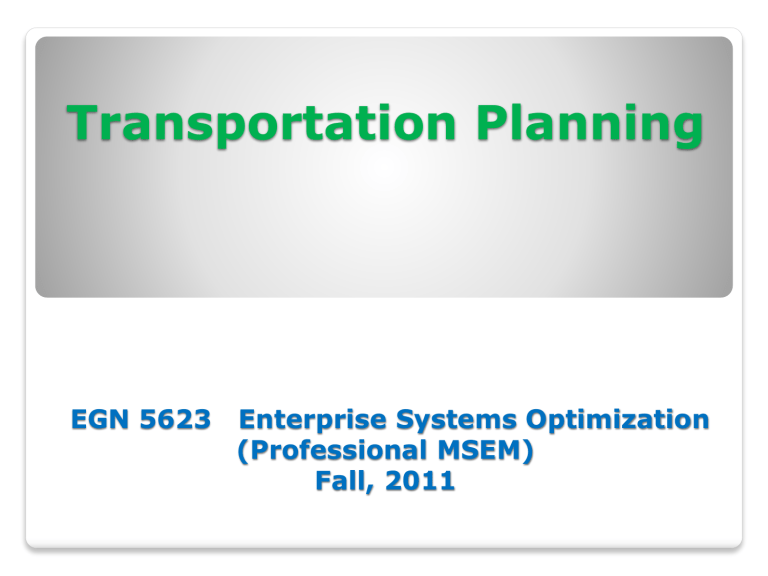
Transportation Planning
EGN 5623 Enterprise Systems Optimization
(Professional MSEM)
Fall, 2011
Transportation Planning
Theories & Concepts
EGN 5623 Enterprise Systems Optimization
(Professional MSEM)
Fall, 2011
Transportation Planning (Overview)
Transportation planning:
• This planning is carried out after delivery note is created in the sales (fulfillment) process.
• It is either executed automatically several times per day to deliver in batches, or manually by the transportation planner.
Objective of Transportation planning:
To group delivery into shipment in order to minimize the number of shipment and the length of the shipments.
TP/VS in SCM (review)
THEORY AND PRACTICE OF ADVANCED PLANNER AND OPTIMIZER IN SUPPLY CHAIN DOMAIN by Sam Bansal
Transportation Planning Overview
Inputs to transportation planning:
• due date of customers’ orders,
• calendars of customers for loading and unloading,
• capacity restriction of vehicles,
• vehicle availability, and
•incompatibility (e.g. of the goods and locations).
TP/VS offers an optimization tool for transportation plan.
The transportation planning creates “shipments” in APO.
Transportation Planning Overview
After creation of a shipment, the subsequent process steps are to select a carrier and to release the shipment.
The shipment is transferred to ERP after it is released in
APO.
Order Life Cycle for Transportation
Planning
Transportation Planning Process in
APO
1. Create shipments in TP/VS
2. Assign transportation resource to each shipment
3. Assign carrier(s) to each shipment
4. Release shipments
Transportation Planning Overview
The common process flow is to create deliveries in ERP first before running TP/VS.
It is important that TP/VS is designed for the transportation planning of a production or trading company and not a transport service provider since TP/VS doesn’t cover some of their common functional requirement but require the master data for products, location, and resources.
Transportation Planning Overview
Planning in TP/VS is possible for orders which contain a start location (LOCFROM) and a destination location
(LOCTO).
Inbound documents:
• purchase orders
Outbound documents:
• delivery notes, sales orders, stock transfer orders, and return orders.
ERP and APO don’t combine inbound and outbound orders in one shipment.
Master Data for TP/VS
The main master data for TP/VS relates the geographical condition:
•locations – manufacturing plant, distribution centers, customers, transportation zone, transport service provider.
•transportation lanes,
•means of transport, and
•vehicle resources.
Master Data for TP/VS
Master Data for TP/VS
Transportation Zone and Transport Service Providers:
The transportation zones and transport service providers
(carriers) are locations of type 1005 and 1020, respectively.
Both are transferred from ERP. The transportation zone implicitly with the customer and the transport service provider using vendor in ERP.
The transportation zone data are stored in Customer
Master data in ERP and are transferred to APO.
TP/VS scheduling methods are predefined in the APO, as shown in next slide.
Vehicle Scheduling Methods List
(A Hierarchy Structure for TP/VS)
Master Data for TP/VS
Transportation Lane:
Transportation lanes are required from plants, DCs to
(customer’s) transportation zone and have to be created manually in APO. The allowed carriers have to be assigned per transportation means and transportation lane (route) explicitly.
The restriction of the validity of a transportation lane per products is ignored by TP/VS.
Carrier Assignment to
Transportation Lane
Detailed Planning in Transportation
Lane
Vehicle Modelling
There are three entities for vehicle modelling:
• Mode
• Means of transport, and
• Vehicle resources
The mode is maintained with the customising path and is used only for grouping purpose, such as by sea, by air, by truck.
The means of transport should correspond either the type of transport vehicle (e.g. one for 20 T truck, one for 40 T truck) or to the transport service provider.
Vehicle resource : type vehicle and category T (e.g. a resource with the capacity of 20 T is not allowed to load 22
T products.
Entities for Vehicle Modelling
Geo-Coding
The calculation of the transport duration depends on the accuracy of geo-coding of the locations and on the accuracy of the distance between locations.
The determination of the geographical settings of locations is performed either based on country and region (standard setting), postal code, or address.
The distance for the transportation lanes is performed either as the air-line distance (standard) or as the actual distance between addresses using a route planning based on the exact longitude and latitude of the locations as input.
Geo-coding Combinations for
Scheduling
TP/VS Optimisation
The optimiser is to create shipments with lowest penalty cost and meet all required constraints.
Hard constraints: compatibilities, opening hours (modelled by handling resource), and finiteness
Soft constraints: earliness and lateness defined in optimiser profile
The TP/VS optimiser is a mixture of local search and evolutionary search. For configuration of the optimiser, the optimiser profile has to be created.
Table 8.1 Costs within the Cost
Profile
Scheduling with Runtime Lanes
In order to generate a schedule with runtime lane, it is critical to determine the distance of the runtime lanes.
The distance of the runtime lanes is either based on GIS information or is calculated using the geo-coding distance and the wiggle factor from the means of transport.
If more detailed distance calculation with geo-coding is used, the mean of transport has to have the option ‘GIS quality’ selected and the average speed for city, country road and motorway have to be maintained.
Scheduling with Runtime Lanes
Carrier Selection
Criteria for selection of carriers:
• service quality based priority, and
• cost.
The carrier selection should be performed after the planning for shipments is done, but before the shipments are transferred to SAP ERP.
If one stage of a transport is already assigned to a carrier who has the flag for continuous move, the same carrier is selected for succeeding stage.
Carrier Selection principle: try to keep the same carrier for Continuous
Move
Transport Load Builder (TLB)
Transport Load Builder (TLB)
The system groups transportation recommendations for individual products together until the minimum values for volume, weight, and number of pallets specified in the TLB profile for creating a load have been reached.
If transportation recommendations cannot be converted, the system generates an alert and the planner can convert the transfers manually.
In the TLB profile, the minimum and maximum values for volume, weight, and pallets are defined per load.
Available-to-deployment (ATD)
In Customizing , you define if you want deployment to create stock transport orders or VMI sales orders.
Alternatively, you can use TLB to group together stock transfer of different products and generate stock transport orders or VMI sales orders with many items for different products.
Transport Load Builder (TLB)
TLB groups plan stock transfers into practical freight units.
The system can create full pallets with mixed products.
You can also define flexible rule relationships for linking the upper and lower limits.
TLB Rules
1.
Connecting upper limits with “and”, lower limits with “or”:
The TLB cannot exceed the defined upper limits when the shipments are built. In addition, at least one of the lower limits must be reached or exceeded in line with how you defined the rule.
2.
Connecting upper limits with “and”, lower limits with
“and”: The TLB cannot exceed any of the defined upper limits. In addition, all defined lower limits must be reached or exceeded.
3. As well as the standard connections, you can also establish user-defined relationship between the rules.
Using the AND and OR operators as well as brackets, you can define which combination of these rules the TLB should use when building the shipments.
Deployment and Transport
Load Builder (TLB)
Summary
Deployment determines which distribution requirements of the distribution centers or VMI customers can be covered by the existing supply. If quantities are sufficient to match demand, Deployment merely confirms the plan. If not it will adjust the stock transfer to take in account the missing quantities.
The TLB, ensure that the means of transport are loaded close to their full capacity or, at least, over their minimum capacity
Transport Load Builder (TLB)
The transport load builder is a short term planning tool to combine confirmed distribution orders to truckloads or other transport units according to the capacity restrictions.
The use of TLB is an optional step in distribution and replenish planning.
TLB planning follows the deployment run and uses confirmed distribution orders as input.
Transport Load Builder (TLB)
The procedure for TLB is to load all selected deployment orders according to the restrictions in TLB-profile (such as straight loading and load balancing).
Straight load:
The orders are stored according to the loading group.
Load balancing:
Distribute the products to be loaded evenly onto different truck loads (see Figure 12.14).
Figure 12.15 shows a procedure for straight loading. The settings to control the procedure for transport load building are maintained in the transportation lane and in product master (see Figure 12.16).
Straight Loading vs Load Balancing
Procedure for Straight Loading
Master Data Setting for TLB
Procedure
Horizon for TLB
The most important horizons for TLB are the planning horizon and the pull-in horizon.
TLB planning horizon defines which distribution orders are taken into account for TLB run.
TLB pull-in horizon defines which orders might be scheduled forward and is maintained in the transportation lane itself.
Starting from the earliest order, combine it with other distribution orders within the TLB pull horizon (until the capacity is full) (see
Figure 12.17).
TLB Horizon
Capacity Restrictions for TLB
The relevant capacity restriction in TLB profile in the following constraints:
Maximum volume,
Maximum weight, and
Maximum number of pallets.
A lower limit exists as well to inhibit uneconomical transport orders.
Transportation Planning
SAP Implementation
EGN 5623 Enterprise Systems Optimization
(Professional MSEM)
Fall, 2011
TP/VS Module in SAP SCM
Note: Strategic network design issues are not handled by SAP SCM
Transportation Planning Overview
Planning in TP/VS is usually performed on basis of deliveries, but it is possible to plan for sales orders as well.
If TP/VS plans for sales orders, planning is performed either on basis of sales orders, sales order items or schedule line. Which of these is used depends on the consolidation level which is a setting on client level and is maintained with the customising path:
APO-> TP/VS-> Basic setting -> Basic setting for vehicle scheduling
TP/VS Planning Board
The central tool for TP/VS planning is TP/VS planning board that is called with transaction SAPAPO/VS01.
When calling the planning board an optimization profile has to be entered. The optimization profile contains restrictions regarding the resources, locations, compatibilities or order types (ATP categories).
Within the planning board it is possible to perform an interactive planning of shipment. There is a consistency check when saving the shipments (e.g. all relevant stages are assigned).
It is possible to create and use heuristics in ‘multi-level planning’ – view of the planning board.
TP/VS Planning Board
Deployment Relevant Setting in
Product Master
Create Work Area for SCM
Maintain Means of Transportation in
SCM
Create Transportation lanes
Change Inbound Quota Arrangement
SCM Project Guidelines
1.
Create a new Vendor (XK01), in EDP
2.
Create a new Customer (XD01), in ERP
3.
Find the latitude and longitude for the above two. in SCM for transportation lane.
4.
Create material master data for a new finished product. at xxA1, xxA2, and xxA3.
5.
Create semi-finished products, at xxA1,optional.
6.
Create new raw materials, at xxA1
7.
Create BOM for the new finished product, at xxA1
8.
Create Routing for the new finished product, at xxA1
9.
Change material type for the new finished product and raw material, in ERP
10. Assign Transportation zone to customers, in ERP
11. Create production version, by entering Version : # # F3
12. Create purchasing information records, using your new raw material
& vendor in ERP
13. Display info records by vendor. (just review)
SCM Project Guidelines
14. Create product group : In the existing group itself add the new finished product and the proportion as 20. Do not use the T code.
Follow the menu path and choose Change.
15. Create SOP plan : may use the same values. Record the plan number.
16. Transfer plan.
17. Check the transfer results in demand management.
18. Integration Models : Create all the models once again. Overwrite the existing model and save it and activate it. Now go back and delete the model created at earlier date. NOTE : When you confirm the data transfer for vendor and customer make sure to add the latitude and longitude for the new vendor and customer.
19. Settings for PDS in SCM : (for the new finished product)
20. Maintain supply chain model in SCM system : Only add the new vendor and customer and location product. Check if the new FG and
RM is included in the location products. Save the model.
SCM Project Guidelines
21. Maintain means of transport in SCM system : Create a new means of transport with the name ##AUSA , description as ##A Truck USA , std code as ##AU . Rest of the parameters remain same.
22. Assign means of transport to transportation lanes in SCM: Do this for new vendor location. Enter means of transport as ##USA .
23. Create transportation lanes in SCM system: When you enter the products enter all the three products and execute the remaining steps. In create means of transport section, enter means of transport as ##AUSA and carry on the next steps as it is.
24. Mass generation of transportation lanes: In the “multiple selection for destination location” add the new customer as well along with the other entries.
25. Display created transportation lanes: Verify if the new changes were incorporated.
SCM Project Guidelines
26.
Assign materials to transportation lanes: In the “multiple selection for product number” section enter the new FG as well along with the other two FG’s and continue the following steps. Repeat this for all the three customers. Between DC and customer: for the all the three customers.
27.
Create quota arrangement: In the “Quota arrangement header” instead of selecting “Mass Selection” check “single selection” and enter the new RM created earlier and click the check mark. Follow the next steps as it is and in the “Quota arrangement item window enter means of transport as ##AUSA. Assign the last remaining new
RM to the new vendor.
28. Master product settings: For the new FG and RM.
29. Model consistency check: Create a new profile ##AGBC and description ##A Consistency Checks .
SCM Project Guidelines
30. Check the consistency of the model: Enter profile name ##AGBC
31. Creation of the remaining Integration models same as we did for the earlier models.
32.
Interactive SNP Planning: Create all the selection criteria’s with a new name for example ##A Finished Products and so on.
NOTE: Enter all the three FG’s when creating for Finished products.
And also check the lower/upper limit of the new RM depending on by what number you have designated it.
33. Review forecast values for production.
34. Run SNP Heuristics - Location at plant level.
35. Location Heuristics for multiple materials on multiple levels.
36. Run SNP Heuristics – Network at the plant level.
37. Run SNP Heuristics – Multilevel at the plant level.
38. Review production plan in product view.
SCM Project Guidelines
39. Create sales order in DC in SAP ECC system: sold to party will be the new customer and the product the new FG and order quantity as per your choice.
40. Network plan with multilevel heuristics.
41. The planning board.
42. Check the results in SAP ERP.
43. Define SNP deployment profile: Product enter the new FG and follow steps on page 127.
44. Assign the TLB profile to the transportation lane: In the section
“means of transport” double click on ##AUSA and follow the next steps. Do the same for ##A1 to ##A3.
45. Run deployment heuristics.
46. Delete transactional data: the upper limit for FG and RM should change according to your products. In “multiple selection for location” all three values should be included.
SCM Project Guidelines
47. Master data selection: In Check Profile enter ##AGBC. Create new selection criteria with new names for example ##A EXTPROC GBC .
NOTE: Make sure to enter all vendors and customers while creating the criteria for location products.
48.
Create CTM profile: In “settings” tab in section check profile enter
##AGBC .
49. Consistency check for CTM master data: Enter check profile as
##AGBC .
50. Planning with CTM.
